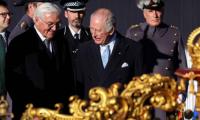Natural gas is environmentally friendly and the most efficient (cheapest) form of thermal energy. After coming to power, the PML-N and former prime minister Shahid Khaqan Abbasi understood that making additional gas available in the system was the only way to fix Pakistan’s energy problems.
Although the country produced a considerable amount of gas, it needed much more to continue working and ensuring industry remained competitive. Pakistan’s gas production was on a continuous decline, and is expected to decline substantially in the coming years. Every sector, including industry and CNG, faced gas loadshedding and the government was forced to run many power plants on furnace oil and diesel.
Previous governments made several attempts to import gas through setting up an LNG import terminal but had failed. Pakistan also signed the Iran-Pakistan Gas pipeline agreement but, given the US sanctions against Iran and regional politics, this or similar projects never took off.
Where others had failed, Abbasi, as part of the Nawaz Sharif cabinet, succeeded in setting up Pakistan’s first LNG terminal in 2015. This LNG terminal is to date the cheapest LNG terminal in the world. (Yours truly also played a part in setting up this terminal and since no good deed ever goes unpunished, both Abbasi and I were beneficiaries of NAB’s solitary confinement and Adiala jail for a few months. But I digress).
Two terminals set-up by the PML-N are contracted to regasify 12 cargoes of LNG per month; both terminals have excess capacity and can regasify 14 cargoes (16 with minor changes) if the government desires or allows. Had the government contracted additional terminal capacity, the debilitating gas shortages that we are facing today wouldn’t have happened and we could have avoided running power plants on furnace oil (which costs twice as much as LNG per unit of power) and diesel (which costs three times as much).
Our government in 2014 started negotiating a contract with Qatar and at the same time two five-year tenders were floated. A Swiss trader, Gunvor, won one tender at 13.37 percent of Brent; Shell, the largest LNG trader, bid the lowest in the second tender at 13.9 percent of Brent but declined to match Gunvor’s price and hence its bid was refused. Qatar was then requested to match this tender-based price and – although the price of a 15-year contract is substantially higher than a five-year contract, and prices of LNG producers are higher than traders – it agreed.
We signed a contract with Qatar at 13.37 percent of Brent, which was the cheapest long-term LNG contract signed until that time and, despite variations and disruptions in the energy markets, remains one of the lowest priced long-term contracts in the world. This price has been used by several countries, including India, as a benchmark to negotiate or renegotiate their contracts; India’s LNG price, renegotiated a month after our contract, is higher than Pakistan’s price.
When the second terminal was due to start operations, the PML-N government signed two more LNG contracts with prices again obtained through a bidding process – one for 15 years with the Italian oil giant ENI for 11.95 percent of Brent and another for 5 years with Gunvor for 11.65 percent.
The PML-N left government in 2018 with a contracted terminal capacity of 12 cargoes, firm long-term contracts for eight LNG cargoes per month, and pipelines to carry 12 cargoes of LNG to the north of Pakistan with the possibility of absorbing another four LNG cargoes in Sindh. All regulatory issues for third party access to LNG were resolved, issues related to setting up merchant LNG terminals were settled, and Ogra determination of tariffs for third party access was provided. SNGPL and SSGC had teamed up to build Pakistan’s first 42-inch pipeline to carry 1,200 million cubic foot per day of gas to northern Pakistan, and an agreement was signed with the Russian government for a similar-sized South-North gas pipeline on BOOT basis. Even Exxon Mobil, the world’s largest oil company, had decided to set-up a merchant LNG terminal in Pakistan.
The PML-N government installed three 1200 MW each LNG power plants, which are the world’s most efficient and convert 61 percent of thermal energy into electricity. This means that for Rs100 worth of LNG, energy worth Rs61 will be converted into electricity; compare this to the average furnace oil plant in Pakistan that converts only Rs35 worth of furnace oil energy into electricity, wasting Rs65 worth of energy. Together with other power plants run on LNG, the demand for just the power sector is over 10 monthly cargoes of LNG; in addition, K-Electric and the CNG sector can use two cargoes each for a total of 14 cargoes per month. Domestic gas can then be used for our homes and industry; even so the domestic gas would not be enough, especially in winter, as our energy demand is expected to grow at over 10 percent.
When the PTI was installed, it promised another two LNG terminals within months. But after two and a half years, neither has work started on new terminals nor capacity enhanced on existing ones. Exxon Mobil has walked away. Investors cite two reasons for losing interest. One is the needs and wants of the Ministry of Maritime Affairs and the other is the petroleum division not laying the pipeline to transport LNG.
New terminals cannot come about until a new pipeline is laid. Why the petroleum division has not started a new pipeline is unfathomable, given that a framework agreement with a Russian government entity was already in place. This inaction has led to huge shortages of gas throughout Pakistan and the production of power on furnace oil and diesel that cost twice and three times as much as LNG respectively. This government’s love affair with furnace oil continues, even as it impoverishes us.
When in the spring of last year, due to Covid, oil and LNG prices were at historic lows, the petroleum division neither bought LNG in a one- or two-year contract (for a fixed price between $3 and $4 per mmbtu) nor converted Pakistan’s existing contracts with Qatar etc to a fixed price between $3.7 and $4.7. As a result, we missed out on an historic opportunity to buy cheap LNG, and also suffered shortages of gas. Unforgivably, we produced electric power in the summer by using diesel and furnace oil.
In late summer, the government again neglected to start a tender process for LNG for the winter months. For January, for instance, the government opened the tender on December 10 and gave itself till December 22 to award tenders. No wonder no one bid for the first three supply windows.
This winter, the government has bought LNG for twice the PMLN-contracted rate. Had the government floated tenders in time, as was done by India, Bangladesh, etc, it would have gotten half the price it’s now getting.
The lowest bidder for one expensive February cargo walked away, while the government was taking its time to award the contract. This shows the benefit of a long-term contract, something the PML-N government had understood – 70 percent of LNG is sold on long term contracts. It is the PML-N’s deals, subjected to false accusations by the current government, that are saving our economy right now.
The writer has served as federal minister for finance, revenue and economic affairs.
Twitter: @MiftahIsmail















